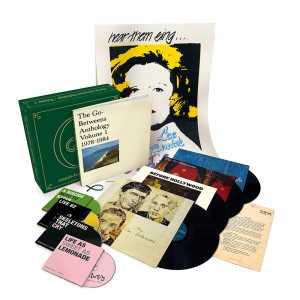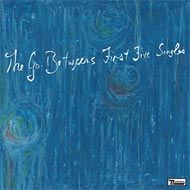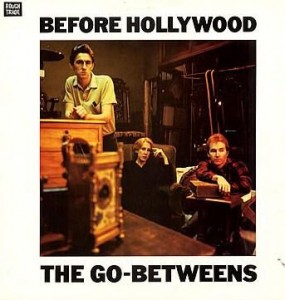The Go-Betweens – G Stands For Go-Betweens Volume 1 1978-1984
Back in October, I wrote about the announcement of the first volume of G Stands For Go-Betweens, a comprehensive box set covering the early years of The Go-Betweens. Shortly after, the good folks at Domino Records sent Sound It Out a digital review copy of the the set’s book and music. Last week, Domino sent out the final product to those customers who pre-ordered the anthology. I haven’t seen or touched the actual box, so I can’t comment on the packaging, the vinyl remastering of the albums, or the physical quality of the book, but I have read the book and listened to all of the music.
1978 through 1984 was a complicated period for the Go-Betweens. They evolved from a duo to a trio to a four-piece. They relocated from Australia to England and then back. Twice. Most significantly, they went from being a band that, in Robert Forster, had a clear leader/singer/songwriter, to becoming legendary for having two frontmen with two distinctive songwriting (and singing) voices. Volume 1 takes on the task of making sense of all of that change.
The book, lovingly compiled by Robert Forster, is jammed with visual ephemera including band photos, original handwritten lyrics, master tape covers, record art, flyers, and press clippings. It includes a discography from the period covered, essays by Forster and others, and a page of typewritten poetry by the late Grant McLennan, Forster’s musical foil in the Go-Betweens. Forster’s essay takes up most of the pages, providing a detailed history of the band’s early days and his friendship with McLennan, told with obvious affection for everyone involved. It’s clear that he intends for this project to be the final, legacy-cementing word on the Go-Betweens, so he’s setting the record straight here, with little of his trademark coy cleverness.
First Five Singles
Over the course of its ten tracks, the vinyl disc First Five Singles tells the story of the Go-Betweens even better than Robert Forster’s essay. Each single is a distilled representation of a stylistic adjustment to the band’s sound, slight or profound, dispatched once a year from 1978 until 1982. The band’s earliest style is represented by the first two singles, “Lee Remick” and “People Say”, blithe, Sixties-inspired pop songs written in a comic, hyper-intelligent-nice-guy-in-love-with-simple-rock-and-roll voice similar to Jonathan Richman‘s. The “Lee Remick” single, released about three months after the formation of the band in 1978 (when Grant McLennan initially picked up a bass guitar, his first instrument), anticipated the jangly UK indiepop of the early-to-mid Eighties (The Pastels, The Brilliant Corners), with its “ba ba bababaa ba dadadada”s and deathless couplets like “she was in The Omen with Gregory Peck/she got killed, what the heck”. The band aptly described their style as “that striped sunlight sound” on the record sleeve.
In 1980 Forster and McLennan recorded their third single, “I Need Two Heads” (b/w “Stop Before You Say It”) in Glasgow, Scotland for the (now-)legendary Postcard Records, revealing what Forster describes as “the first ‘cracking’ or ‘fragmenting’ of the more melodic, Sixties-influenced lines” of his songwriting. The strummy, sunny pop was replaced by a stripped-down sound somewhere between New Wave and post-punk, and very similar to Three Imaginary Boys-era Cure (who the pair had witnessed live in London weeks before).
A year later, “Your Turn, My Turn” found the band, with new drummer Lindy Morrison, fully embracing a terse, telegraphic sound. Robert Forster’s lyrics for the next couple of years would be minimalistic and impressionistic, usually employing just two or three small words per line, often repeated for emphasis.
All of the single sides up to that point had been sung by Forster.
In 1982, Grant McLennan provided the band’s fifth single, the knotty, Morse code-like “Hammer The Hammer”. Lyrically and sonically, it arrived at a place similar to Forster’s concurrent material, but came at it from a slightly different angle; where Forster frequently sounded detached and aloof, McLennan sang with warmth and earnestness. On his first major song contribution, McLennan was already displaying a distinct point of view, one that fit in with the band’s existing sound and complemented Forster’s songwriting sensibility. It’s likely that the band didn’t realize it at the time, but “Hammer The Hammer” marked the beginning of the dynamic that came to define the Go-Betweens: Robert Forster and Grant McLennan as equal partners, each contributing half of the band’s new material.
First Three Albums
Along with First Five Singles, the band’s first three albums provide the truly essential material in the set.
1981’s Send Me A Lullaby was recorded at the end of the Forster-dominated period, with Grant McLennan providing only two songs, his first on record. It’s the Go-Betweens at their most raw and jagged, eschewing the pop of their early singles, trying to find their voice. The guitar sounds are clean and dry, but there’s a distinct metallic vibe to the overall sound and performances, and a self-consciously “difficult” sensibility to the songs. Forster referred to it as “metallic folk”. “Eight Pictures” is a highlight, with lyrics about a camera-wielding stalker, and a hilariously artless, almost Shaggs-like Lindy Morrison drum solo. Send Me A Lullaby is a great full-length debut, but of the band’s classic six-album run (through 16 Lovers Lane), it’s the one I come back to the least. For me, the Go-Betweens’ peculiar magic relies heavily on a careful balance of Forster and McLennan material, and the resultant tension and flow.
Before Hollywood is the first album on which McLennan sang as many songs as Forster, and is the best of the first three. Working with producer John Brand in England, the band refined the ragged, staccato sound of Send Me A Lullaby to create what Forster describes in the book as “post-punk angles with songs”. There’s a controlled beauty to the sound that reminds me of another early Eighties masterpiece on the Rough Trade label, Colossal Youth by Young Marble Giants. The two albums don’t sound very similar, but both have a remarkable clockwork quality to their rhythms and melodic figures, as well as a hard-to-pinpoint anachronistic character that suggests post-punk made by candlelight in some unspecified, earlier era. “Cattle And Cane”, McLennan’s meditation on the fragility of memory, sounds like nothing else, and has achieved mythic status over the decades.
The band’s third album, Spring Hill Fair, has long been regarded by Robert Forster as a bit of a misstep by the band, a rush job meant to sustain the momentum put into motion by Before Hollywood. But to me it sounds like the logical next step, a seamless transitional move toward the idiosyncratic-but-relatively traditional pop of the albums that would follow. The band had expanded to a four-piece, with Robert Vickers taking over on bass so that Grant McLennan could move to guitar full-time. The first song, McLennan’s “Bachelor Kisses”, is a rare Go-Betweens love song, sweet and sentimental. “Draining The Pool For You” finds Robert Forster returning to a wry lyrical voice, singing about being exasperated from doing menial work for rich philistines. Elsewhere, the band perform material in the same vein as Before Hollywood, but with a muscular production closer to regular ol’ rock and– exploiting the new two-guitar lineup– peppered with Television-styled lead workouts.
Bonus Material
The four bonus discs offer typical box-set stuff: lots of demos, live recordings, radio sessions, more singles, outtakes, and alternate versions. All of it is worth hearing–even the band’s lesser material is very good– but none of it touches First Five Singles or the proper albums. The first disc, Life As Sweet As Lemonade, covers the period from 1978-79, and consists entirely of Forster-sung material in the bright pop mold of “Lee Remick” and “People Say”. It starts off with one of the genuine surprises of the box set: “I Wanna Be Today”, a Who-inspired mod-pop nugget, unlike anything else in the band’s catalog. It’s hard to believe the Go-Betweens kept it unreleased for so long; it seems like a highlight of the period. All of the non-single material from the 1999 release 78 ‘Til 79: The Lost Album appears here, but it’s significantly slower than on that CD, sounding slightly sluggish and tuned-down (i.e. it seems that the slower speed is incorrect and accidental, a tape transfer error, not a correction). It is possible that this has been addressed and/or fixed since I got the digital review copy.
The other big (pleasant) surprise in the bonus material is Rarities Volume Three: Live At The Mosman Hotel, April 23, 1982. It’s a terrific twelve-song set, beautifully recorded and featuring the Forster/McLennan/Morrison lineup in top form. They sound tight and confident, and the show includes material spanning from “I Need Two Heads” through Before Hollywood, including a couple of otherwise-unreleased numbers. Again, it’s hard to believe that they kept something this good (and revealing) unreleased for so long.
G Stands For Go-Betweens: Volume 1 comprehensively documents the formative years of an enigmatic and fascinating group. It’s very exciting to hear the restless band struggling and learning. Volume 2 will certainly be filled with some of the Go-Betweens best music, but it will tell the story of a band who have grown up and comfortably settled into a hard-earned identity. It will be hard to top Volume 1.







